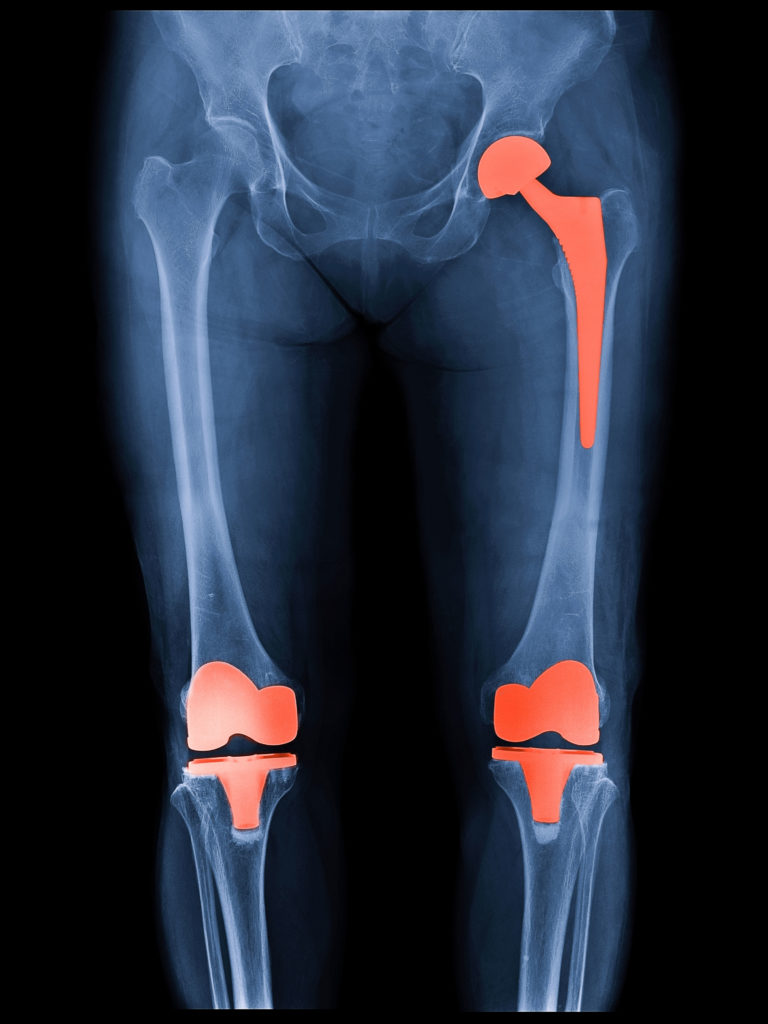New developments in joint replacement surgery & rehabilitation

The use of joint replacement surgery for hip and knee pain has evolved greatly since I started my Physical Therapy career many years ago.
Joint replacement is occurring in younger individuals
Younger individuals are having joint replacement surgery. Data from 2000 to 2009 for individuals from 45 to 64 years old there was a 188% increase for total knee replacement surgery. For total hip replacement surgery, there was a 123% increase.
Because younger individuals are having joint replacement surgeries the desires and expectations of younger and more active individuals often include returning to sports after joint replacement. Marco Konings and colleagues documented the desires and expectations of patients to resume sports activities after total knee replacement has increased significantly in recent years.
Recommendations for return to sporting activity after joint replacement surgery remains controversial. Recommendations regarding return to sports after joint replacement is still currently based on expert opinion rather than scientific data. So, recommendations vary.
A review of literature by Alexander Hooorntje and colleagues reports most hip replacement surgery patients returned to work and sports. The type and level of sports activity varied. There is evidence of a return to a high level of sports activity. Michael Rochoy and colleagues report 18 runners with knee or hip joint replaced ran an ultramarathon (Ultra-Trail du Mont Blanc 106-mile). Fifty percent of the total hip replacement runners finished and 75% of total knee replacement runners finished. Brielle Antoneilli and colleagues report 12% of runners were able to return to running after joint replacement surgery.
Less involvement by Physical Therapists
Over the last several years the amount of face-to-face Physical Therapists' involvement in the rehab process has decreased. Post joint replacement surgery protocols often use self-directed home-based exercise or web-based self-directed rehab. Following a post-surgical protocol is relatively simple. Individuals with an athletic mindset have potential to mess things up a bit by competing to exceed the protocol guidelines. Find a Physical Therapist who understands and appreciates the desires and expectations to return to sport but can avoid the mistake of doing too much too soon.

Improvement in activity/function not so great
The goal of joint replacement surgery and post-op rehab is to eliminate pain and improve physical abilities and function. However, a review of the research shows mixed results. John Arnold and colleagues report despite the improvements in surgery and post-surgery rehab the functional improvement 1-year post is negligible. Dana Judd and colleagues report 1 year post joint replacement surgery strength, function, and gait remain below normative for healthy age-matched individuals. Most individuals who stopped participating in sports activities prior to surgery do not reinitiate their sports activities after surgery. Vikki Wylde and colleagues report a quarter of patients are unable to perform their valued leisure activities 1 year after total hip replacement surgery.
Joint replacement post-surgical results which do not reach full potential may be a result of several factors including fear of damaging the surgery, overly conservative guidance from the surgeon and/or Physical Therapist, insufficient rehabilitation, and shortcomings of self-reported functional measures.
Historically, self-reported functional measures have been used to measure the outcome of joint replacement surgery. Queries regarding the individual’s perception of pain and abilities or inabilities to do activities will determine the effectiveness of surgical and rehab interventions. The standard self-reported functional outcomes measures are effective to rate differences in outcomes for the older population. The standard self-reported outcome measures do not have questions appropriate for younger individuals interested in returning to higher-level sporting activities.
Simon Talbot and colleagues suggest a new self-report outcome measure, the High Activity Arthroplasty Score which addresses the shortcoming of a ceiling effect. A ceiling effect is there is little or no room to detect improvements. The “High Activity Arthroplasty Score” raises the ceiling providing for more differentiation. It includes measures of participation in recreational sports.
Novel approach
Kathleen Madara and colleagues propose a novel approach of progressive rehabilitation after joint replacement surgery. The program reduces the early supervised Physical Therapy visit and introduces higher level of progressive exercises much later in the recovery process. Intervention is fit to the individual patient goals including recreational and sporting activity.
This approach can take advantage of the cost-effective self-directed home-based and web-based joint replacement post-surgical programs. It can address the shortcomings regarding achieving higher level expectations of younger individuals desiring to return to high-level recreational sporting activities.
Bottom Line:
- After finishing the initial phase of joint replacement post-surgical protocol, ask what do I need to do to be able to return to my pre-surgery recreational sport activity?
- If you have had joint replacement surgery and are not satisfied with the degree of functional improvement, consider a consult with a Physical Therapist
- To achieve full benefits from joint replacement after completing the standard post-surgical rehab protocol consider progressing to a more aggressive exercise and sports participation rehab program under the direction of a Physical Therapist.
The information on this website is not intended or implied to be a substitute for professional medical advice, diagnosis, or treatment. You are encouraged to perform additional research regarding any information contained available through this website with other sources and consult with your physician.
Damien Howell Physical Therapy – 804-647-9499 – Fax: 866-879-8591 At-Home, At Office, At Fitness Facility – I come to you, I do home visits Damien@damienhowellpt.com
